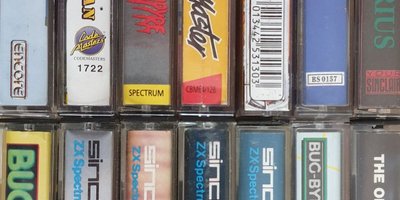This was my first article specifically written for Medium in an attempt to find new channels for the results of my research. Since I’ve closed my account there, I’m moving the article to the Vintrospektiv homepage.
The British scene
The home computer and gaming scene of the 1980s in Great Britain was strikingly different from other countries. It had its own models, companies and trends that were partly virtually unknown in the rest of the world. This article sets out to explain the differences and explore the reasons.
Even though many of the early milestones of arcade gaming originated in Japan, English was established early on as the language of video games. And while three American companies — Apple, Commodore and Radio Shack — produced the best-selling early home computers all over the world, the English companies Sinclair and Acorn followed a different strategy. As early as 1980, they produced two computers that sold for around £100 or $240 as a kit, and were immensely popular in Great Britain: the Sinclair ZX-80 from £80 and the Acorn Atom from £120.
In fact, the British home computer scene remained focused on low-cost models throughout most of the 1980s, which meant that more modern models by Sinclair (the Spectrum) and Acorn (the BBC Micro) with cassette tape rather than floppy disk drives dominated the British market. Even game consoles were much less prevalent in Britain than in other countries.
The tape sector, which was practically abandoned in most other countries by the mid-eighties in favour of floppy disks, therefore continued to play an important role in Britain, and while computer games generally cost as much there as in other countries, a thriving budget segment developed. For instance, Mastertronic started out with cheaply produced (and mostly not too complex) titles at £1.99 each, while Firebird had the “Silver” label at £2.50. Later, labels like “Ricochet” by Mastertronic and the “199 range” by Alternative Software re-released popular titles at similar prices.
Overall, a large part of the British game business was ignored in other countries, especially the U.S., and while games like Elite by Firebird were international triumphs, other British hits were issued under different names in the U.S., e.g. The Sentinel as The Sentry, or remained largely unknown like Manic Miner or Skool Daze.
Throughout the 1980s, the Sinclair Spectrum was the linchpin of the British gaming business, and while other markets quickly lost interest in the 8-bit machines after the mid-eighties, almost all British games up to 1990 received a tape port to the Spectrum, if it was technically at all feasible.
The British scene produced its own major companies and creators. Names of composers and, to a lesser extent, graphic artists were well-known among computer gamers throughout the world, but in the UK, designers like the Pickford Brothers (Glider Rider), the Oliver Twins (Dizzy) or Mike Singleton (Lords of Midnight) were real stars, and companies were all too happy to finance their games. Even in the very beginning of the home computer explosion, names like Jeff Minter (whose llama-themed games are still famous even today) were widely recognised.
An important development that set the British market apart from those in other countries was the rise of independent game creators. The focus on self-assembly kits and tape media made it possible for everyone to produce and sell games, which led to magazines reserving sections to mail-order offers from independent game designers who often started out as a one-person company and grew with their success.
One such company was Level 9, widely recognised as the English answer to the text game champions Infocom, who started as three brothers creating a clone of the first adventure game called Colossal Adventure, and soon grew big enough to employ their parents for the business aspects and mail duty. For long years, the company solely comprised the Austin family, until they struck deals for publication and distribution of their games. (See the Level 9 Fact Sheet by Manuel Schulz and myself for much more information about this remarkable company.)
Most set out to become a big player from the beginning, though many of the biggest firms don’t exist anymore: Bug-Byte (dissolved, name sold to Argus), Imagine (bankrupt), Mastertronic (merged with Virgin and later dissolved), Ocean (became a sub-label of Infogrames, then Atari, then Bandai Namco), Palace (sold to Titus, who later went bankrupt) were all hugely successful companies in their time, even though some of them were hardly known beyond the channel.
In addition to the already mentioned Manic Miner, Bug-Byte published close to a hundred other games, among them clones of popular arcade titles and UK releases of international hits. Imagine was resposible for games like Ah Diddums and Zzoom, both of which were quite well-received. Mastertronic had many hit releases, like the titles of the Darling Brothers (The Last V8, BMX Racers), who later formed Codemasters — the only English company founded in the 1980s that still exists. Ocean is probably the least obscure name, well-known all over the world for film franchise games like Batman: The Movie or RoboCop. Finally, Palace was mostly known for the games designed by Steve Brown (Cauldron, Barbarian: The Ultimate Warrior), who had no background in games and therefore stood out creatively because he didn’t know the rules.
But there were dozens of other companies who published thousands of games between them, names like Argonaut Games, Gremlin Graphics, Quicksilva or U.S. Gold., who are all now long gone.
On the other hand, the companies who mostly concentrated on the 16-bit computers, and therefore disk media, were often famous internationally for titles like Xenon, The Chaos Engine (The Bitmap Brothers), Populous (Bullfrog), Lemmings, Shadow of the Beast (Psygnosis), Alien Breed and Worms (Team17), many of which became long-lived franchises. Interestingly, though, England’s own 16-bit (or rather 32-bit) system, the Acorn Archimedes, was once again commercially only successful in the UK, Australia and New Zealand.
In the nineties, the scene began to change: 8-bit computers had reached the end of their shelf life, the PC was on the rise, and the emerging internet was transcending country borders. Only those companies survived that were able to accomodate the new market realities: either by expanding to other countries and computers, or at least by modernising their offerings and starting to sell them internationally. The others were invariably confronted with a new breed of customers who wanted increasingly larger-scale games that made use of new hardware features. The time of tape-based games that fit into memory had come and gone.
For a while, though, innovation and creativity had flourished in Great Britain in a segment of the gaming world that was tightly defined by inexpensive hardware and the games to go with it.
(The featured image is a photo of a small part of my collection, taken by myself.)



Comments are closed.